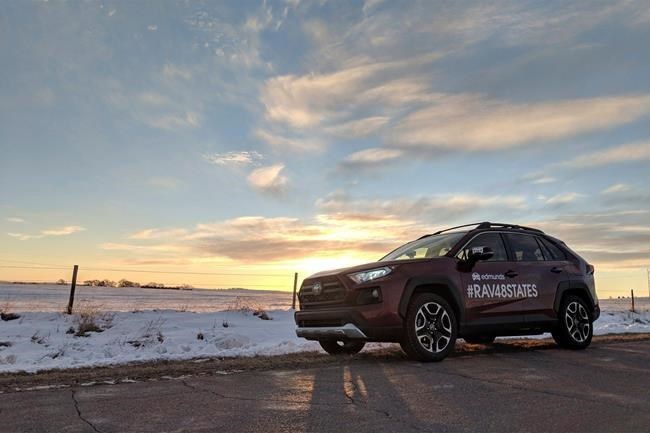
This December 2018 photo provided by Edmunds shows the 2019 Toyota RAV4 in Nebraska, on the fifth day of a marathon test drive from Kittery, Maine, to Needles, California, touching all 48 contiguous states. The trip taught our editors the particular value of four car features: torque-vectoring all-wheel drive, winter tires, high-quality headlights and built-in navigation. (Edmunds via AP)
Republished January 23, 2019 - 6:28 AM
Original Publication Date January 23, 2019 - 4:06 AM
You don't complete a 7,100-mile, 48-state road trip without learning a few things, especially if you go in the grips of winter. A group of Edmunds editors made such a journey in December, in just seven days. Along the way, they encountered amazing vistas, dark and lonely roads, and plenty of rain, subfreezing temperatures and snow. Here are four takeaways that stood out above the rest.
TORQUE-VECTORING ALL-WHEEL DRIVE EXCELS IN SNOW
Four-wheel drive (4WD) and all-wheel drive (AWD) are not interchangeable terms. The 4WD systems found on most pickups are meant to be engaged after the vehicle has left the road. These systems lack something called a centre differential, so binding and slippage will occur while turning if you use 4WD on pavement. It's not an issue on dirt and snow; such surfaces shift to alleviate the binding.
AWD systems can operate on pavement because they have a centre differential or a similar mechanism. The resulting lack of binding makes them better able to cope with rain, snow and ice because tires maintain more consistent contact with the surface. More advanced AWD systems have an active centre differential that varies the front-to-rear distribution of the engine's power to reduce tire slippage and improve stability during acceleration.
Our clear favourite is a subgenre called torque-vectoring AWD. Such systems also redistribute power side to side across the rear axle, which helps to reduce slippage and improve stability on iffy surfaces during sharper turns and accident-avoidance manoeuvrs. The Adventure trim level of the 2019 Toyota RAV4 we tested on this trip has such a system, and it gave us a lot of confidence. Various brands offer torque-vectoring AWD systems, but the names differ. Honda calls its system Super Handling AWD (SH-AWD), for instance.
WINTER TIRES OFFER CLEAR BENEFITS
They're often called snow tires, but winter tires is a better name because they also provide added grip on frigid pavement even when there's no snow. Winter tires work in two ways: Their specialized tread features numerous fine cuts known as "sipes" that give them myriad biting edges. They also employ a specialized rubber formulation that remains grippy and pliable in subfreezing conditions.
All-season tires have a year-round mission, providing warm-weather grip and durability, not to mention quietness and fuel efficiency. This compromise results in a modest level of winter performance that's best suited for those who see occasional light snowfall. In many areas, safety officials do not consider all-season tires suitable for tough conditions. They'll demand tire chains.
Winter tires are by far the better choice for those who live with real winter, particularly if hills and winding roads are involved. Our test-drive route included more than 2,500 miles of subfreezing temperatures and numerous high mountain passes, so we fitted a set of winter tires before we reached the Northern Plains and Rocky Mountain states. In the High Rockies, our vehicle remained confident and well-planted where others struggled.
HEADLIGHTS REALLY MATTER
Away from cities, it's still dark out there. We drove many roads that were completely unlit, and we often saw no other cars. Several rural states had 80 mph interstate speed limits, but we even found narrow two-lane roads posted at 65 mph or more. These dark rural stretches tend to host wildlife ? big leaping animals such as deer, antelope and elk. We also drove through open grazing lands where cattle roam free, usually black-coated herds that blend in with the night.
The ability to see far ahead is critical in such conditions. But in these conditions, the only light you have is what your car can provide. Headlight technology has been evolving rapidly, with LED headlights generally offering the best illumination. But there's still a lot of variation in performance, so the Insurance Institute for Highway Safety recently began testing and rating headlight performance.
DON'T WRITE OFF BUILT-IN NAVIGATION
Apple CarPlay and Android Auto let you operate your smartphone's navigation apps via a vehicle's touchscreen. But there are limitations. You must own a smartphone with a good-size data plan. You must also be driving in an area where your specific provider offers data coverage.
Such coverage is not a given in every corner of our country, especially if you use back roads away from the interstates, as we often did. But it's more common than that: There are several "no service" areas less than 50 miles from downtown Los Angeles. There are workarounds, such as pre-saving routes or initiating guidance when you have service. But only a vehicle's built-in navigation lets you see maps and establish guidance when there's no data-level cell service.
EDMUNDS SAYS:
Even if you don't drive 7,100 miles in a week, safe travel in tough conditions and unfamiliar terrain is a lot easier and more enjoyable if you have the right vehicle and equipment to suit the trip.
___
This story was provided to The Associated Press by the automotive website Edmunds. Dan Edmunds (no relation) is the director of vehicle testing at Edmunds: Twitter @Edmunds_Test
Related links:
Edmunds Article: 2019 Toyota RAV4 Ultimate Review https://edmu.in/2Egqo4r
Edmunds Video: 2019 Toyota RAV4 Ultimate Review https://bit.ly/2RFPCRG
News from © The Associated Press, 2019